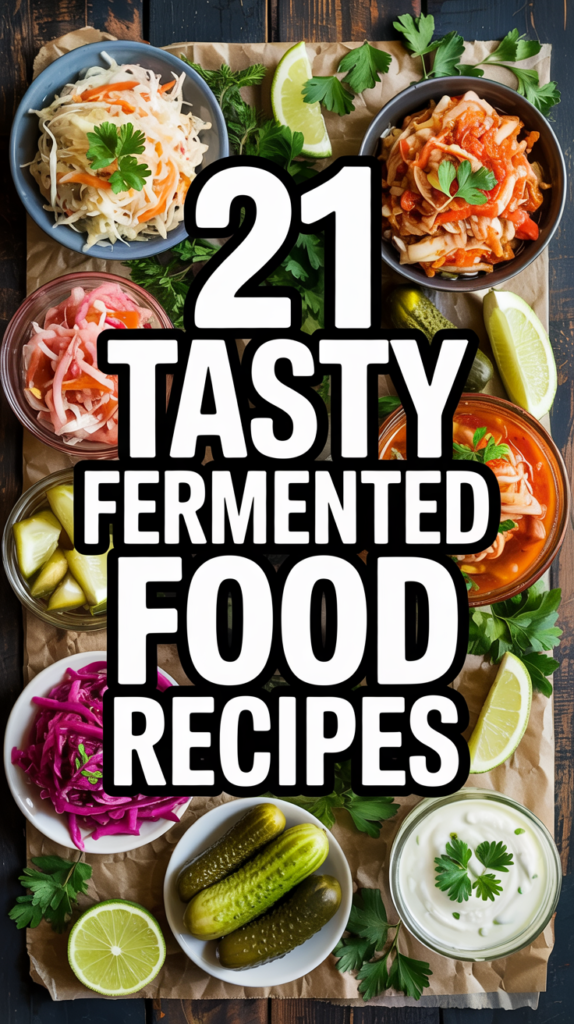There’s something truly satisfying about making your own fermented foods at home. Not only are they delicious, but they also work wonders for your gut health. From tangy sauerkraut to fizzy kombucha, these DIY projects are both fun and rewarding.
Thank you for reading this post, don't forget to subscribe!I’ve always been inspired by Kelli Foster’s cookbook, The Probiotic Kitchen, which shows how easy it is to incorporate these ingredients into everyday meals. Whether you’re a beginner or a seasoned pro, there’s a recipe for everyone.
In this guide, I’m excited to share 21 beginner-friendly ideas that cover everything from breakfast to dinner. Trust me, once you start, you’ll fall in love with the process and the results!

Key Takeaways
- Homemade fermented foods are both tasty and beneficial for gut health.
- DIY projects like sauerkraut and kombucha are easy and fun to make.
- Kelli Foster’s The Probiotic Kitchen is a great resource for inspiration.
- These recipes are perfect for beginners and cover all meal types.
- Creating your own fermented dishes is a rewarding and healthy habit.
Introduction to Fermented Foods
Exploring the world of fermented foods opens up a universe of flavor and health benefits. These culinary creations are more than just tasty—they’re packed with live probiotics that support your gut health. Let’s dive into what makes them so special and why they’ve been a staple in diets worldwide for centuries.
What Are Fermented Foods?
Fermentation is a natural process where microorganisms like bacteria and yeast break down starches and sugars. This transformation creates compounds like lactic acid or alcohol, which preserve the ingredients and enhance their flavors. Think of sourdough bread, tangy kimchi, or creamy yogurt—these are all products of fermentation.
Good bacteria, such as lactobacilli, play a key role in this process. They’re not harmful but essential for maintaining a healthy balance in your body. From fermented soybeans like miso and natto to dairy products like kefir, these foods are celebrated in cuisines across the globe.
Why Fermented Foods Are Good for Your Gut
The live probiotics in fermented foods help balance your gut bacteria. This balance is crucial for digestion, immunity, and even nutrient absorption. Lactic acid, a byproduct of fermentation, not only preserves the food but also makes it easier to digest.
Incorporating these foods into your diet can boost your overall health. They support your immune system and help your body absorb nutrients more efficiently. Whether it’s a spoonful of yogurt or a serving of kimchi, these foods are a simple way to nourish your body from the inside out.
The Benefits of Fermented Foods
Adding probiotic-rich dishes to your diet can transform your health in surprising ways. These creations are packed with live cultures that support your gut, boost your immunity, and enhance nutrient absorption. Let’s explore how they work and why they’re worth incorporating into your daily routine.

Improving Digestion
One of the most immediate benefits is better digestion. The bacteria in these dishes help break down lactose and gluten, making them easier to process. If you’ve ever struggled with bloating or irregularity, adding a small serving to your meals can make a noticeable difference.
I’ve found that pairing a spoonful of kimchi with my lunch not only adds flavor but also keeps my stomach feeling light. Homemade versions are especially beneficial since they avoid preservatives found in store-bought options.
Boosting Immunity
A healthy gut is closely linked to a strong immune system. Studies show that a diverse microbiome can reduce inflammation and lower the risk of infections. The lactic acid produced during fermentation plays a key role in this process.
Regularly consuming these dishes can help your body fend off illnesses more effectively. It’s like giving your immune system a natural boost without any extra effort.
Enhancing Nutrient Absorption
These dishes also increase the bioavailability of essential nutrients. Vitamins B and K, for example, become more accessible to your body after fermentation. This means you get more out of every bite.
I love adding a variety of these sides to my meals to maximize their benefits. Whether it’s a tangy sauerkraut or a creamy yogurt, each one offers unique advantages that support overall health.
How to Incorporate Fermented Foods into Your Diet
Incorporating these probiotic-rich ingredients into your daily routine is easier than you think. From breakfast to snacks, there are countless ways to enjoy their benefits. Let’s explore some simple ideas to make them a regular part of your meals.

Breakfast Ideas
Start your day with a yogurt parfait layered with fresh fruit and granola. It’s a quick and delicious way to fuel your morning. For a refreshing twist, blend kefir into smoothies with berries and a splash of milk.
Another great option is adding a spoonful of sauerkraut to your avocado toast. The tangy flavor pairs perfectly with creamy avocado, making it a satisfying breakfast choice.
Lunch and Dinner Recipes
For lunch, try a tempeh stir-fry loaded with colorful veggies and a savory sauce. It’s a hearty and protein-packed dish that’s easy to prepare. At dinner, drizzle miso paste over roasted veggies or use it as a glaze for salmon.
Add natto to salads or grain bowls for an extra protein boost. Its unique texture and flavor make it a standout addition to any meal.
Snacks and Beverages
Snack on fermented pickles paired with hummus for a crunchy and tangy treat. For a fizzy drink, enjoy a kombucha mocktail with a splash of fruit juice. These options are perfect for satisfying cravings while keeping your gut happy.
Don’t forget to use sauerkraut as a topping for hot dogs or a mix-in for salads. It’s a versatile side that adds flavor and nutrition to any meal.
| Meal Type | Idea |
|---|---|
| Breakfast | Yogurt parfait with fruit and granola |
| Lunch | Tempeh stir-fry with veggies |
| Dinner | Miso-glazed salmon |
| Snacks | Fermented pickles with hummus |
| Beverages | Kombucha mocktail |
Top 21 Fermented Food Recipes
Discovering the art of fermentation can transform your kitchen into a hub of flavor and health. These dishes are not only delicious but also packed with live probiotics that support your gut. Let’s dive into three standout creations that are perfect for beginners and seasoned enthusiasts alike.

1. Homemade Sauerkraut
This tangy classic is a great way to start your fermentation journey. With just cabbage, salt, and time, you can create a probiotic-rich side that pairs perfectly with sausages or sandwiches. “The simplicity of sauerkraut makes it a favorite for beginners,” says one enthusiast. With a 4.8-star rating, it’s a crowd-pleaser.
Tip: Use a fermentation weight to keep the cabbage submerged. This ensures even fermentation and prevents mold.
2. Classic Kimchi
Kimchi is a staple in Korean cuisine, known for its spicy, tangy flavor. Made with napa cabbage, radishes, and a blend of spices, it’s a versatile dish that can be enjoyed on its own or as a topping.
“The key to great kimchi is patience—let it ferment for at least a week for the best flavor.”
For a twist, try adding carrots or apples for a hint of sweetness. It’s a great way to experiment with flavors.
3. Creamy Yogurt
Homemade yogurt is surprisingly easy to make and tastes fresher than store-bought versions. All you need is milk and a starter culture. The result is a creamy, probiotic-rich treat that’s perfect for breakfast or snacks. “I love adding fresh fruit and honey for a quick, healthy dessert,” shares one home cook.
Tip: Use a yogurt maker for consistent results, or simply wrap your jar in a towel to keep it warm during fermentation.
These recipes are just the beginning. Whether you’re making tangy pickles or fizzy kombucha, each creation brings its own unique benefits to your table. Start small, experiment, and enjoy the process of crafting your own probiotic-rich dishes.
Tips for Successful Fermentation at Home
Mastering the art of fermentation at home can be both rewarding and straightforward with the right approach. Whether you’re a beginner or an experienced enthusiast, these tips will help you achieve consistent results and avoid common pitfalls. Let’s dive into the essentials for successful fermentation.

Choosing the Right Ingredients
High-quality ingredients are the foundation of great fermentation. Opt for organic produce to avoid pesticides that can interfere with the process. Sea salt is a better choice than iodized salt for vegetable ferments, as it doesn’t inhibit the growth of beneficial bacteria.
Using filtered water is also crucial. Chlorine in tap water can disrupt the natural fermentation process. For dairy-based ferments, choose fresh, high-quality milk to ensure the best results.
Maintaining Proper Hygiene
Cleanliness is key to preventing mold and unwanted yeast. Always sterilize jars and utensils before starting. I’ve found that boiling jars or using a dishwasher’s sanitize cycle works well.
If you notice a white film called kahm yeast, don’t panic. It’s harmless and can be skimmed off. However, proper hygiene minimizes its occurrence. Keeping your workspace clean ensures a smooth fermentation process.
Storing Fermented Foods Correctly
Proper storage extends the life of your creations. Use airtight jars and store them in cool, dark places to slow down fermentation. Once the desired flavor is achieved, refrigerate to preserve the texture and taste.
Labeling jars with dates helps track progress and ensures you use them at their peak. Fermentation weights are also helpful to keep ingredients submerged, preventing exposure to air and mold.
| Tip | Details |
|---|---|
| Ingredients | Use organic produce and sea salt |
| Hygiene | Sterilize jars and utensils |
| Storage | Store in airtight jars in cool, dark places |
Conclusion
Embracing the world of gut-friendly creations can be a game-changer for your health. These fermented dishes are not only versatile but also packed with benefits that support digestion, immunity, and overall well-being.
Start small by trying one easy recipe, like sauerkraut or yogurt. Adding just a spoonful to your daily meals can make a big difference. Over time, you’ll discover how simple it is to incorporate these recipes into your routine.
I’d love to hear about your journey with these dishes! Share your successes in the comments below. Remember, even small steps toward healthier food choices can lead to lasting benefits.
FAQ
What are fermented foods?
Why are fermented foods good for my gut?
How can I add fermented foods to my meals?
What are some easy fermented food recipes to try at home?
What tips should I follow for successful fermentation?
Related Posts
- 5 Healthy Low-Carb Crockpot Recipes for Effortless Dinners
Looking for healthy low-carb dinner ideas that require minimal effort? These 5 Crockpot recipes are…
- 15 Best Keto Comfort Food Recipes: Satisfying Low-Carb Meals for Every Craving
Craving the warmth and satisfaction of comfort food while sticking to your keto diet? Look…
- Gluten-Free Comfort Food Recipes: 15 Delicious Ideas for Every Occasion
Craving the indulgence of comfort food but need to keep it gluten-free? You’re in the…





